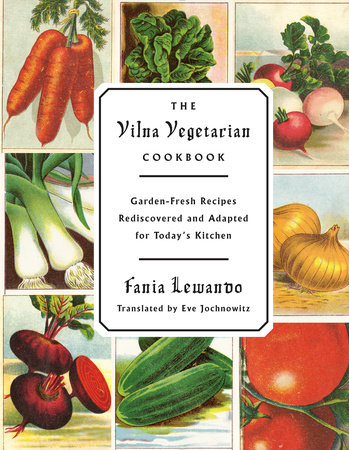THE VILNA VEGETARIAN COOKBOOK
BY FANIA LEWANDO (1938)
Garden-Fresh Recipes Rediscovered and
Adapted for Today’s Kitchen
With a Foreword by Joan Nathan
and Translations from Yiddish and
Annotations by Eve Jochnowitz
U.S. Publication Date: May 26, 2015
Schocken Books
In 1938, Fania Lewando, the proprietor of a popular vegetarian restaurant in Vilna, Lithuania, where all the hip Yiddish speaking intellectuals ate and conversed, published a Yiddish vegetarian cookbook unlike any that had come before. Her establishment was the Elaine’s of Vilnius, and ot for those without some coins. Marc Chagall dined there (although he was not feeling well the night he signed the guest book), as did Itzik Manger (he said it was heavenly), Dr. Halevi, Zalmen Maynzer, Yudl Mark, Lazar Kahan, and other (male) luminaries. In 2011, The Forward referred to the cookbook as Vilna’s Moosewood cookbook.


Well, YIVO did more than just commission a translation.
Barbara Mazur and Wendy K. Waxman were participating in a YIVO book group when they saw the 1938 book. Mazur and Waxman wanted to publish a reprint of it. They spied famed cookbook author and food journalist, Joan Nathan, at Stone Barn in New York State and showed her their manuscript, which they just happened to have on them. Actually they found out that Nathan was speaking there and cornered her in a parking lot. Ms. Nathan not only said yes to their request for her to write the Foreword, but she hooked them up with a top editor – Altie Karper – at Schocken. Nathan said that people always approach her with ideas for cookbooks and that she decided that it has to be worth it and it needs to contribute to the Jewish food field. This book was and is the real deal. Nathan recently told a reporter for The Chicago Tribune that Lewando was a trailblazer, and that everything you read gives the reader a sense of the life that was and the life that was lost and the life we should all live.

Nevertheless, I found it fascinating.
The 400 recipes range from traditional Jewish dishes (kugels, blintzes, fruit compotes, borschts) to vegetarian versions of Jewish holiday staples (cholent, kishke, schnitzel) to appetizers, soups, main courses, and desserts. Unusual dishes not usually seen by me are recipes for Chickpea Cutlets, Jerusalem Artichoke (Sunchoke) Soup; Leek Frittata; Apple Charlotte with Whole Wheat Breadcrumbs.The ‘taxonomy’ of the cookbook is dizzying, and reminds one of a menu from Shopsin’s Manhattan diner.
There are SALADS (Mayonnaise Provencal, Tomato, Eggplant Appetizer, Apple with Horseradish Salad, Fresh Cucumber Salad); SOUPS (mandlen soup nuts, carrot, beer, lentil, almond, apricot, cold cherry, semolina, oatmeal, mushroom, sago, potato, farina with milk, farina with water, rice, farfel, beet, cabbage, borscht, bran borscht, sorrel, ukranian, kapusniak soups); VEGETARIAN CUTLETS (celeriac, bean, nut, egg, cauliflower, lisitschkes, potato stuffed with mushroom, oat, lima bean); STEWED DISHES (TSIMES) (stewed prunes, sauerkraut with peas, potato with sour cream, stewed cabbage, stuffed cabbage, cucumbers with tomatoes, lentils, pears, kohlrabi);
MISCELLANEOUS DISHES (mock meatloaf, kishke, mock caviar, various creamed vegetables, noodles with prunes, leeks with butter, pierogies of various types, cherry varenikes, bigos, carrot schnitzel, raspberry mousse, stuffed zucchini, rolls with jam fried in butter, cauliflower wiener schnitzel, potato zrazy, baked eggs with peppers); BLINTZES; OMELETS; PORRIDGES; FRITTATAS; eleven KUGELS WITH CHOLENTS; nine PUDDINGS; ten types of LATKES; eight items for PASSOVER; SUBSTANTIAL PUDDINGS (such as rice, noodle pudding with milk, buckwheat pudding, potato pudding); eight SAUCES AND CREAMS; sixteen STUFFED FOODS (kreplakhs, stuffed eggs, dumplings, stuffed peppers); BAKED GOODS (about thirty baked items including Challah Charlotte, sponge cake, cabbage pie, apple cake, poppy, oil, rye flour with honey cookies and cakes); JAMS AND PRESERVES; a dozen TURNOVERS: two dozen COMPOTES AND DESSERTS (kissles, ices, jellies, creams); GLAZES FOR CAKES; COFFEE BUTTERMILK AND YOGURT (move over Greek style, try Armenian Matsoni); MARINATED FOODS; ICES; WINES MEAD AND LIQUEURS; and VITAMIN DRINKS AND MIXES.WHEW!!!!
One of the funniest recipes is for bread for those with a stomachache. It requires 55 cups of flour. The editor asks readers that if anyone makes it, please let them know if it worked as a cure.Dr. Efraim Sicher, a professor at Ben-Gurion University of the Negev in Be’er Sheva Israel is a great-nephew of Lewando’s, helped with the biographical details of the reprint. Lewando was “no ordinary woman,” according to Dr. Sicher. She taught nutrition classes in her own dietary school, and she sought to interest the English branch of H.J. Heinz in her recipes. She even worked as a chef aboard a Polish ocean liner. Then came World War II. Lewando and her husband were last seen, according to Sicher, being captured by Soviet soldiers as they sought to flee the Nazis in 1941. Eve Jochnowitz, a New York City-based culinary ethnographer who translated and annotated the book, said, “…the recipes are really good and [readers] are going to want to cook and eat them. They are not the least bit dated. There are a couple of things that are labor intensive but there are plenty that are very easy. The recipes are vivid, flavorful, (and) surprising.”


The book closes with some of the messages from the restaurant’s guest book from some of the greatest Yiddish luminaries of pre-War Vilna, Riga, Kovno, and points elsewhere.











cbd how to use
Has anybody been to Luxor Vapors? 😉
Do You enjoy watching movies as I do? Visit Film izle! Ciao!
Thanks for the great info! I would never have found this on my own!
Its unusual for me to discover something on the web thats as entertaining and fascinating as what youve got here. Your page is lovely, your graphics are great, and whats more, you use source that are relevant to what youre talking about. Youre definitely one in a million, keep up the good work!